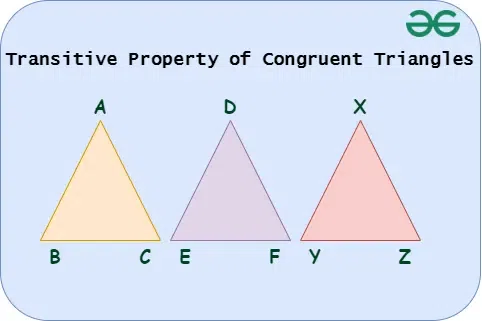
|
|
Transitive Relation is one of the necessary conditions for equivalence relation, as for any relation to be that needs to to Transitive at first. In Transitive Relation, if element A is related to element B and element B is related to element C, then there must also be a relationship between element A and element C, following the same rule or relation. In other words, if A relates to B and B relates to C, then A must relate to C. This article provides a well-rounded description of the concept of “Transitive Relation”, including definitions, examples, and properties.
Table of Content What is a Relation?In math, a relation is like a rule that tells us how things in one group are connected to things in another group. Imagine we have two groups, A and B. A relation between them shows which items in A are linked to items in B. Think of it as drawing lines to connect them. There are many types of relations, including reflexive, symmetric, antisymmetric, transitive, asymmetric, and equivalence relations, each defining specific patterns of connections between elements in mathematical sets. Read more about Relation and Function. What is Transitive Relation?Transitive Relations or Transitive Relationships are all about maintaining a clear chain of connections among their elements. If element A is connected with element B and element B is connected with element C then it logically follows that element A must also be connected with element C. Transitive Relation DefinitionMathematically, a relation R on a set A is said to be transitive if, for all elements a, b, and c in set A:
Properties of Transitive RelationsThere are some properties of Transitive Relations that are discussed as follows: Inverse of a Transitive RelationThe inverse of a transitive relation is itself a Transitive Relations
Union of Two Transitive Relations
Intersection of Two Transitive RelationsThe intersection of two transitive relations is itself a transitive relation.
Read More, Transitive Relation ExampleSome examples of transitive relationships are:
Let’s see an example in detail. Example: Consider a set of natural numbers and define a relation R as follows: (1, 2), (2, 3), (1, 3). Check if relation R is transitive. Solution:
Other Relations Related to Transitive RelationSome of the other types of relations related to the concept of transitive relations are:
Let’s discuss these relation in detail. Anti-Transitive RelationAn anti-transitive relationship works differently. If A is connected with B and B is connected with C then A can’t be connected with C. It’s the opposite of transitivity and is useful in various mathematical contexts.
Intransitive RelationIntransitive relations don’t follow the clear chain rule. If A is connected with B and B is connected with C then it doesn’t guarantee that A is connected with C. Such relations often appear in complex real-world situations.
Transitive Property of Congruent TrianglesFor 3 triangles say △ABC, △DEF, and △XYZ, as shown in the image added below:  Transitive Property of Congruent Triangles If, △ABC ≅ △DEF △DEF ≅ △XYZ Then, △ABC ≅ △XYZ This is called transitive property of congruent triangles. Read More, Example of Transitive RelationExample 1: Imagine a set of students and define a relation “is taller than” as follows:
We want to know if this relation is transitive. Solution:
Example 2: Let’s consider a set of numbers and define a relation “is divisible by” as follows:
We want to determine if this relation is transitive. Solution:
Example 3: Let’s consider a group of animals and define a relation “is a predator of” as follows:
We want to determine if this relation is transitive. Solution:
Practice Problems on Transitive RelationProblem 1: Let R be a relation on the set of all integers defined as follows: For any integers a and b, (a, b) is in R if and only if a is a multiple of b. Determine whether R is a transitive relation. Problem 2: Consider the set A = {1, 2, 3, 4, 5} and define a relation R on A such that (x, y) is in R if and only if x is greater than y. Determine whether R is a transitive relation. Problem 3: Let S be a set of all people, and define a relation R on S as follows: (x, y) is in R if and only if x is a sibling of y. Determine whether R is a transitive relation. Problem 4: Given a set A = {a, b, c, d, e}, define a relation R on A such that (x, y) is in R if and only if the sum of the ASCII values of the characters in x is greater than the sum of the ASCII values of the characters in y. Determine whether R is a transitive relation. Problem 5: Consider a relation R on the set of real numbers defined as follows: (x, y) is in R if and only if |x – y| ≤ 1. Determine whether R is a transitive relation. Transitive Relation – FAQsDefine Transitive Relation.
Is there another name for a Transitive Relation?
How can you determine if a Relation is Transitive?
Can a Transitive Relation have exceptions where the connection breaks?
Are all Hierarchical Structures Transitive Relations?
What Are Some Common Examples of Transitive Relations?
How Do You Represent a Transitive Relation Mathematically?
Can a Relation Be Reflexive, Symmetric, and Transitive Simultaneously?
Can a Relation Be Both Transitive and Symmetric?
Are There Relations That Are Not Transitive?
|
Reffered: https://www.geeksforgeeks.org
| Class 11 |
Type: | Geek |
Category: | Coding |
Sub Category: | Tutorial |
Uploaded by: | Admin |
Views: | 12 |